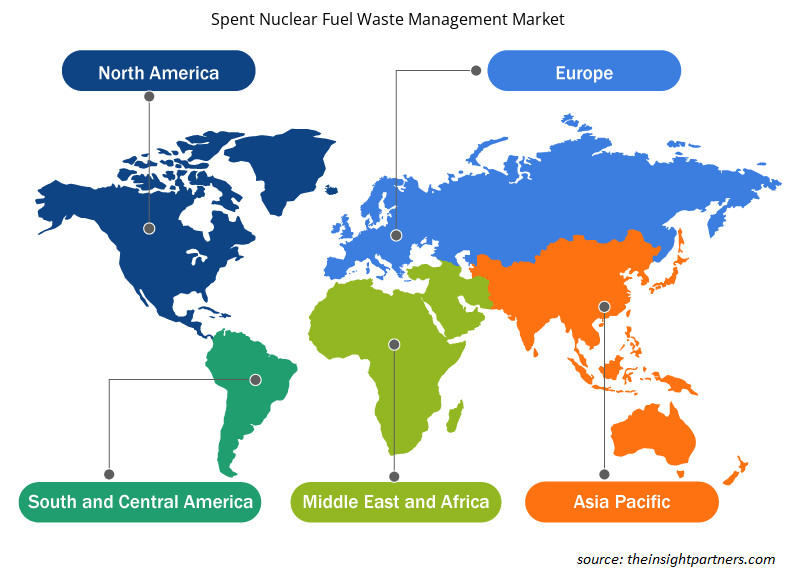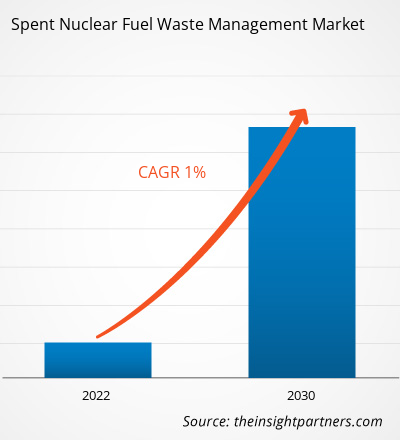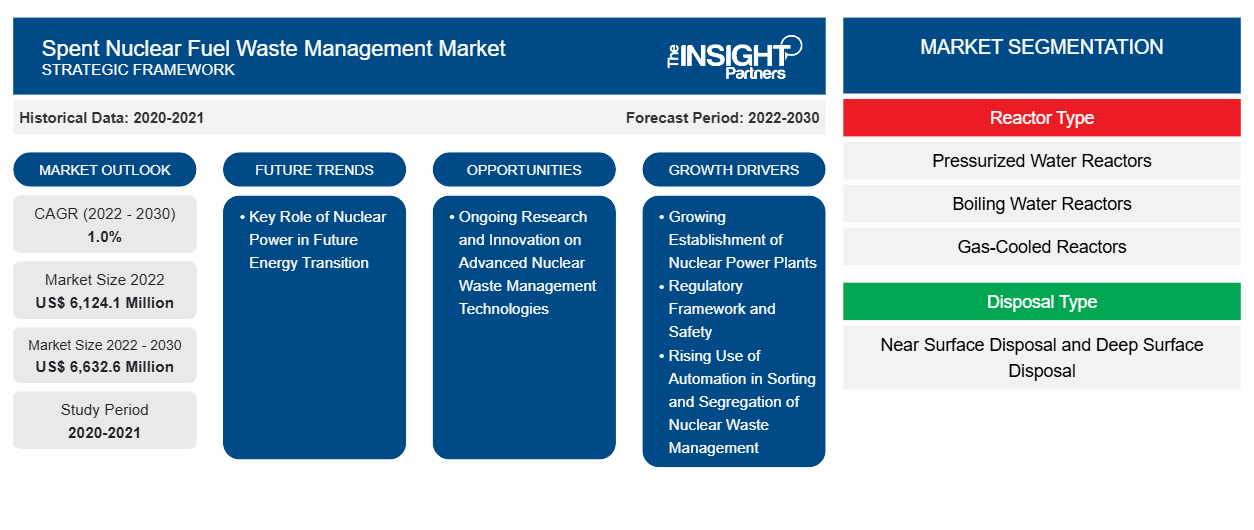使用済み核燃料廃棄物管理市場規模は、2022年の61億2,410万米ドルから2030年には66億3,260万米ドルに達すると予測されています。市場は2022年から2030年にかけて1.0%のCAGRを記録すると予想されています。核廃棄物管理を支持し、新たなゼロ炭素排出目標の達成を目指す政府の政策と義務の拡大は、使用済み核燃料廃棄物管理市場を牽引する主な要因の1つです。
使用済み核燃料廃棄物管理市場分析
使用済み核燃料廃棄物管理の世界市場は、原子力プロジェクトの増加と使用済み核燃料廃棄物の管理に対する規制の強化により、分析期間中に大幅な成長を遂げると予想されています。さらに、核廃棄物管理のための深地層処分の開発は高度な段階にあり、環境の持続可能性の目標を達成すると予想されています。使用済み核燃料のより良い管理を促進するための全体的な核廃棄物管理インフラストラクチャへの投資の増加は、世界の使用済み核燃料廃棄物管理市場を後押ししています。
使用済み核燃料廃棄物管理市場の概要
人口増加と工業化に伴い、エネルギー需要も世界的に高まっています。エネルギー消費量の増加により、原子力発電の必要性も高まりました。この結果、世界中で使用済み核燃料廃棄物管理市場の需要が高まっています。一部の国では、MOX燃料の製造と使用を通じて、使用済み燃料を再処理し、プルトニウムやウランなどの使用可能な材料をリサイクルするための先進的で革新的な技術がすでに使用されています。一部の国では、核燃料サイクルを持続可能にし、最終的に処分しなければならない廃棄物の量と放射性毒性を最小限に抑えるために、より複雑な再処理技術が開発されており、肥沃で長寿命の放射性核種もリサイクルしています。これらのリサイクル技術は、高速炉燃料の長期的な使用をサポートすることを目的としています。
要件に合わせてレポートをカスタマイズする
このレポートの一部、国レベルの分析、Excelデータパックなど、あらゆるレポートを無料でカスタマイズできます。また、スタートアップや大学向けのお得なオファーや割引もご利用いただけます。
- このレポートの主要な市場動向を入手してください。この無料サンプルには、市場動向から見積もりや予測に至るまでのデータ分析が含まれます。
使用済み核燃料廃棄物管理市場の推進要因と機会
原子力施設の設置増加
世界中で急速な工業化と都市化が進む中、エネルギー需要の高まりが原子力発電の成長を牽引し、今後数年間で原子力施設の増設の必要性が高まることが予想されます。現在、32か国と台湾で約440基の原子炉が稼働しており、総発電容量は約390GWeです。2022年には、世界の電力の約10%に相当する2,545TWhが供給されました。既存の原子力エネルギープログラムを持つ多くの国が、新しい原子炉の建設を計画しているか、建設中です。これらの新興経済国の数は多いものの、近い将来、原子力発電容量の拡大に大きく貢献することは期待されていません。主な成長は、技術がすでに確立されている国で発生します。したがって、世界中でエネルギー需要が高まることで、2022年から2030年にかけて原子力発電所の増設が促進され、今後数年間で使用済み核燃料廃棄物管理市場が拡大すると予想されます。
将来のクリーンエネルギーへの移行とエネルギー安全保障における原子力発電の重要な役割
原子力発電が世界全体の発電量に占める割合は約10%だが、先進国では20%近くにまで上昇している。歴史的に、原子力は世界最大のカーボンフリー電力供給源の一つとなっている。一部の国では大きな課題に直面しているものの、エネルギー部門の脱炭素化に大きく貢献する可能性を秘めている。さらに、原子力発電所は、需要と供給の大きな変化に応じて出力をある程度調整できるため、電力網の安定性を保ち、脱炭素化戦略を補完するなど、さまざまな方法でエネルギー安全保障に貢献している。風力や太陽光発電(PV)などの変動性再生可能エネルギーの割合が増加するにつれて、そのようなサービスの必要性が高まるだろう。したがって、将来のクリーンエネルギーへの移行とエネルギー安全保障における原子力発電の重要な役割は、2022年から2030年にかけて使用済み核燃料廃棄物管理部門で事業を展開する主要企業に機会を生み出すと予想される。
使用済み核燃料廃棄物管理市場レポートのセグメンテーション分析
使用済み核燃料廃棄物管理市場分析の導出に貢献した主要なセグメントは、原子炉タイプと処分タイプです。
- 原子炉の種類に基づいて、使用済み核燃料廃棄物管理市場は、加圧水型原子炉(PWR)、沸騰水型原子炉(BWR)、ガス冷却型原子炉、その他に分類されています。加圧水型原子炉(PWR)セグメントは、2022年に大きな市場シェアを占めました。
- 使用済み核燃料廃棄物管理市場は、処分方法に基づいて、近地表処分と深地表処分に分けられています。深地表処分セグメントは、2022年に大きな市場シェアを占めました。
使用済み核燃料廃棄物管理市場シェアの地域別分析
使用済み核燃料廃棄物管理市場レポートの地理的範囲は、主に北米、ヨーロッパ、アジア太平洋、中東およびアフリカ、南米の 5 つの地域に分かれています。
2022年の使用済み核燃料廃棄物管理市場は、ヨーロッパが主導権を握っています。ヨーロッパ地域には、ドイツ、フランス、スペイン、ロシア、英国、その他のヨーロッパが含まれます。エネルギー需要の増加は、ヨーロッパと中東地域全体の地政学的緊張による石油とガスの価格の上昇または変動によるものです。最近、ベルギーは、現在の原子炉2基の運転を2025年から2035年まで延長することを決定しました。これにより、電力需要の約15%がカバーされます。さらに、フィンランドのオルキルオト3号機は、2023年4月に正式に運転を開始しました。これは、西ヨーロッパで15年ぶりの新しい原子炉です。さらに、フランスは2022年に、電力需要の約10%を満たす6基の新しい大型原子炉を建設することに合意し、さらに8基を建設するオプションがあります。最初の原子炉の稼働は2035年に予定されています。
使用済み核燃料廃棄物管理市場の地域別分析
予測期間を通じて使用済み核燃料廃棄物管理市場に影響を与える地域的な傾向と要因は、Insight Partners のアナリストによって徹底的に説明されています。このセクションでは、北米、ヨーロッパ、アジア太平洋、中東、アフリカ、南米、中米にわたる使用済み核燃料廃棄物管理市場のセグメントと地理についても説明します。

- 使用済み核燃料廃棄物管理市場の地域別データを入手
使用済み核燃料廃棄物管理市場レポートの範囲
| レポート属性 | 詳細 |
|---|---|
| 2022年の市場規模 | 61億2,410万米ドル |
| 2030年までの市場規模 | 66億3,260万米ドル |
| 世界のCAGR(2022年 - 2030年) | 1.0% |
| 履歴データ | 2020-2021 |
| 予測期間 | 2022-2030 |
| 対象セグメント | 原子炉の種類別
|
| 対象地域と国 | 北米
|
| 市場リーダーと主要企業プロフィール |
|
使用済み核燃料廃棄物管理市場のプレーヤー密度:ビジネスダイナミクスへの影響を理解する
使用済み核燃料廃棄物管理市場は、消費者の嗜好の変化、技術の進歩、製品の利点に対する認識の高まりなどの要因により、エンドユーザーの需要が高まり、急速に成長しています。需要が高まるにつれて、企業は提供を拡大し、消費者のニーズを満たすために革新し、新たなトレンドを活用し、市場の成長をさらに促進しています。
市場プレーヤー密度とは、特定の市場または業界内で活動している企業または会社の分布を指します。これは、特定の市場スペースに、その市場規模または総市場価値に対してどれだけの競合相手 (市場プレーヤー) が存在するかを示します。
使用済み核燃料廃棄物管理市場で事業を展開している主要企業は次のとおりです。
- アウゲアン社
- Perma-Fix Environmental ServicesInc.
- スヴェンスク カーンブランスレハンタリング AB
- アンサルド・エネルギア
- USエコロジー社
- ヴェオリアグループ
免責事項:上記の企業は、特定の順序でランク付けされていません。

- 使用済み核燃料廃棄物管理市場のトップキープレーヤーの概要を入手
使用済み核燃料廃棄物管理市場のニュースと最近の動向
使用済み核燃料廃棄物管理部門は、重要な企業出版物、協会データ、データベースを含む一次調査および二次調査後の定性的および定量的データを収集することによって評価されます。以下は、使用済み核燃料廃棄物管理市場と戦略の市場動向のリストです。
- 2023 年 7 月、Perma-Fix Environmental Services は、United Association of Plumbers and Steamfitters Local Union 598 と提携しました。この提携は、ハンフォードのタンクの修復作業を加速することが期待される廃棄物処理オプションの提供を目的としています。
- 2020年1月、ヴェオリアグループの子会社であるヴェオリア・ノース・アメリカは、米国ガムスプリングスにあるアルコアUSAコーポレーションの有害廃棄物処理施設を買収し、有害廃棄物処理およびリサイクル活動事業を拡大する契約を締結した。
使用済み核燃料廃棄物管理市場レポートの対象範囲と成果物
「使用済み核燃料廃棄物管理市場の規模と予測(2020〜2030年)」レポートでは、以下の分野をカバーする市場の詳細な分析を提供しています。
- 対象範囲に含まれるすべての主要市場セグメントについて、世界、地域、国レベルでの市場規模と予測
- 市場の動向(推進要因、制約、主要な機会など)
- 今後の主な動向
- ポーターのファイブフォース分析の詳細
- 主要な市場動向、主要プレーヤー、規制、最近の市場動向を網羅した世界および地域の市場分析
- 市場集中、ヒートマップ分析、主要プレーヤー、最近の動向を網羅した業界の状況と競争分析
- SWOT分析による詳細な企業プロフィール
- 過去2年間の分析、基準年、CAGRによる予測(7年間)
- PEST分析とSWOT分析
- 市場規模価値/数量 - 世界、地域、国
- 業界と競争環境
- Excel データセット
最新レポート
関連レポート
お客様の声
購入理由
- 情報に基づいた意思決定
- 市場動向の理解
- 競合分析
- 顧客インサイト
- 市場予測
- リスク軽減
- 戦略計画
- 投資の正当性
- 新興市場の特定
- マーケティング戦略の強化
- 業務効率の向上
- 規制動向への対応























 無料サンプルを入手 - 使用済み核燃料廃棄物管理市場
無料サンプルを入手 - 使用済み核燃料廃棄物管理市場